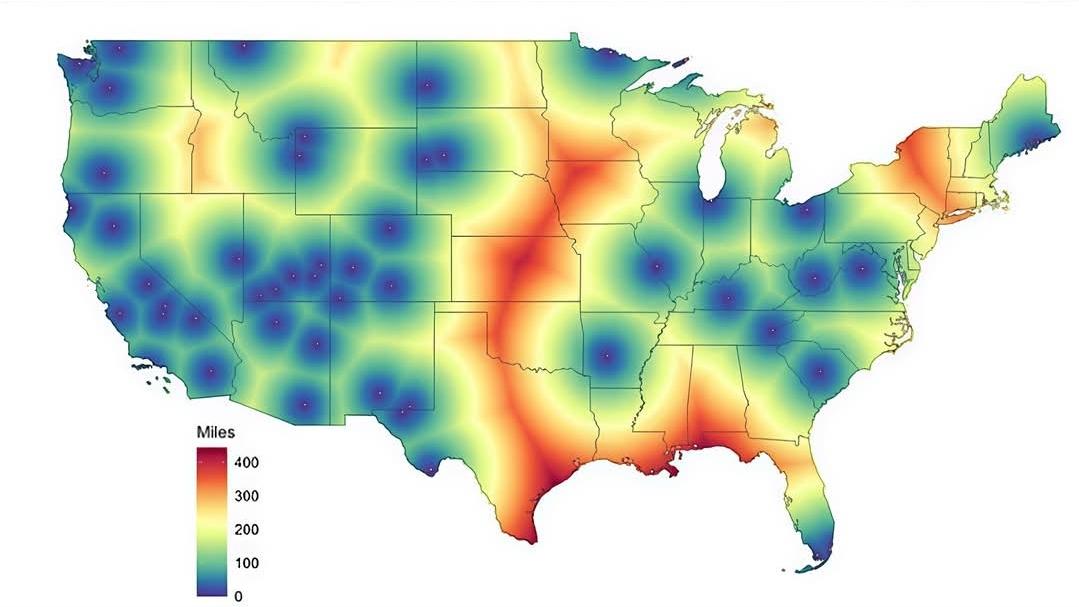Proximity to the Nearest National Park Map


Marcus Rodriguez
Historical Geography Expert
Marcus Rodriguez specializes in historical cartography and geographic data analysis. With a background in both history and geography, he brings unique...
Geographic Analysis
What This Map Shows
The "Proximity to the Nearest National Park Map" provides a visual representation of how far individuals live from the nearest national park in various regions. This map not only highlights the accessibility of these natural wonders but also emphasizes the disparities in proximity across different populations. It’s crucial in understanding how geographic location can influence recreational opportunities, conservation efforts, and public health outcomes.
Deep Dive into National Parks and Their Importance
National parks serve as vital sanctuaries for biodiversity, cultural heritage, and recreational spaces. Established to preserve the natural environment and provide public access to stunning landscapes, national parks also play a significant role in conservation efforts. Did you know that there are over 400 national parks across the United States alone? Each park has its unique ecosystem, wildlife, and cultural significance.
Interestingly, national parks contribute not just to ecological preservation but also to the economy. In 2021, national parks attracted approximately 297 million visitors, generating around $18.4 billion in economic output. This revenue supports local businesses, creates jobs, and enhances community well-being.
Moreover, the proximity to national parks can significantly influence the quality of life for residents. Research has shown that access to green spaces, such as national parks, promotes physical health and mental well-being. Ever wondered why people often feel rejuvenated after spending time in nature? Studies indicate that spending time in natural settings can lower stress levels, enhance mood, and boost overall health.
What's fascinating is the role that national parks play in education. They serve as outdoor classrooms for students and visitors alike, providing hands-on experiences that foster a deeper understanding of environmental stewardship, geology, and history. For example, Yellowstone National Park, established in 1872, was the first national park in the world and remains a living laboratory for scientific research.
However, access to these natural treasures is not uniform. Some communities are located mere miles from expansive parks, while others may be hundreds of miles away. This disparity raises important questions about equity in access to natural resources and recreational opportunities.
Regional Analysis
Looking at the map, we can see significant regional differences in proximity to national parks. For instance, states like California and Utah are home to several national parks, including Yosemite and Zion, respectively. Residents in these states generally enjoy easy access to multiple parks, enhancing their recreational options and quality of life.
Conversely, residents in the Midwest and certain areas of the South may find themselves far removed from the nearest national park. For example, states like Nebraska and Iowa have limited national park facilities, which can mean a drive of several hours just to visit a park. This can affect not only leisure activities but also local tourism and economic benefits associated with national parks.
Interestingly, urban areas often boast a higher concentration of visitors to nearby parks. Cities like Denver, Colorado, provide residents with quick access to the Rocky Mountain National Park, encouraging regular outdoor activities and a lifestyle intertwined with nature. However, urban parks may not offer the same expansive experiences as larger national parks, leading to a potential gap in outdoor experiences for city dwellers.
Significance and Impact
Understanding the proximity to national parks is more than just a matter of geography; it has significant implications for public health, environmental policy, and community development. As urban areas continue to grow, the push for accessible green spaces becomes increasingly critical. Conservation efforts must take into account not only the protection of these parks but also the accessibility for surrounding communities.
Moreover, the ongoing climate crisis emphasizes the need for preserving natural landscapes. National parks serve as critical habitats for wildlife and play a role in climate regulation. Increased accessibility to these parks can foster a greater appreciation for nature, leading to stronger advocacy for environmental protection.
Looking ahead, trends suggest that the popularity of national parks will continue to rise, especially as people seek refuge from urban life. As awareness grows about the importance of outdoor recreation for mental health, proximity to national parks may increasingly influence property values and urban planning. Communities that prioritize access to parks may find themselves more attractive to residents and businesses alike, fostering a healthier and more engaged population.
In conclusion, the Proximity to the Nearest National Park Map is not just a tool for navigation; it reflects deeper societal trends and challenges. It encourages us to think critically about how we engage with nature and the importance of ensuring that everyone, regardless of where they live, has access to the restorative power of national parks.
Visualization Details
- Published
- October 24, 2025
- Views
- 22
Comments
Loading comments...